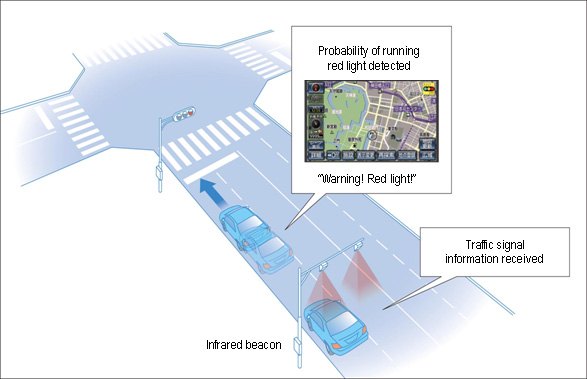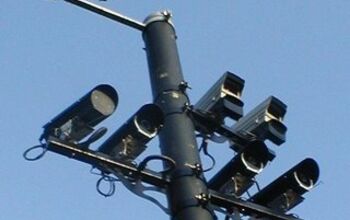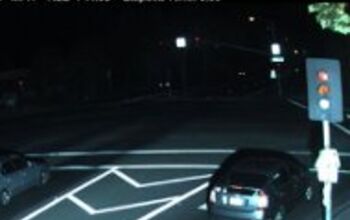Red Lights In Japan

Whereas speed cameras are plenty in Japan, the use of red light cameras has yet to catch on in the land of the rising sun. Instead of viewing red lights as revenue sources, Japan (which certainly could use the funds) is spending money in a big way to make red lights and stop signs safer. The Japanese National Police Agency is starting to roll out its Driving Safety Support System (DSSS) in Japan in July. Instead of waiting for someone to run a read light, and then dispatching a costly ticket, this system attempts to reduce the instances of red lights run. Toyota and other Japanese manufacturers are starting to integrate their cars into this system.
Basically, car navigation systems receive traffic information from roadside infrared beacons. This is not macro information, warning you about a traffic jam you most likely already sit in. It is fine-grained and highly targeted information about what is sometimes literally just around the corner.
This is how it works: There are roadside infrared beacons that communicate with on-board Driving Safety Support System (DSSS) receivers. They feed the information into the on-board navigation computer. It informs the driver about five possible situations:
Red light warning: A roadside infrared beacons signals the car that a read light is ahead.If the on-board system detects the possibility of running a red light, it alerts the driver.
Green light alert: Prior to the traffic light changing to green, a notification is given to the driver. No more honking necessary from fellow drivers.
Stop sign warning: A warning is sent to the driver if the system detects the possibility of the vehicle running a stop sign. There goes another souce of revenue.
Stationary vehicle ahead: Sensors ahead of the vehicle gather traffic data. If there is a stationary or low-speed vehicle ahead, the driver receives a notification.
Blind corners: If there is a vehicle around a blind corner, drivers on the road with the right-of-way are notified.

Bertel Schmitt comes back to journalism after taking a 35 year break in advertising and marketing. He ran and owned advertising agencies in Duesseldorf, Germany, and New York City. Volkswagen A.G. was Bertel's most important corporate account. Schmitt's advertising and marketing career touched many corners of the industry with a special focus on automotive products and services. Since 2004, he lives in Japan and China with his wife <a href="http://www.tomokoandbertel.com"> Tomoko </a>. Bertel Schmitt is a founding board member of the <a href="http://www.offshoresuperseries.com"> Offshore Super Series </a>, an American offshore powerboat racing organization. He is co-owner of the racing team Typhoon.
More by Bertel Schmitt
Latest Car Reviews
Read moreLatest Product Reviews
Read moreRecent Comments
- Kwik_Shift_Pro4X Thankfully I don't have to deal with GDI issues in my Frontier. These cleaners should do well for me if I win.
- Theflyersfan Serious answer time...Honda used to stand for excellence in auto engineering. Their first main claim to fame was the CVCC (we don't need a catalytic converter!) engine and it sent from there. Their suspensions, their VTEC engines, slick manual transmissions, even a stowing minivan seat, all theirs. But I think they've been coasting a bit lately. Yes, the Civic Type-R has a powerful small engine, but the Honda of old would have found a way to get more revs out of it and make it feel like an i-VTEC engine of old instead of any old turbo engine that can be found in a multitude of performance small cars. Their 1.5L turbo-4...well...have they ever figured out the oil dilution problems? Very un-Honda-like. Paint issues that still linger. Cheaper feeling interior trim. All things that fly in the face of what Honda once was. The only thing that they seem to have kept have been the sales staff that treat you with utter contempt for daring to walk into their inner sanctum and wanting a deal on something that isn't a bare-bones CR-V. So Honda, beat the rest of your Japanese and Korean rivals, and plug-in hybridize everything. If you want a relatively (in an engineering way) easy way to get ahead of the curve, raise the CAFE score, and have a major point to advertise, and be able to sell to those who can't plug in easily, sell them on something that will get, for example, 35% better mileage, plug in when you get a chance, and drives like a Honda. Bring back some of the engineering skills that Honda once stood for. And then start introducing a portfolio of EVs once people are more comfortable with the idea of plugging in. People seeing that they can easily use an EV for their daily errands with the gas engine never starting will eventually sell them on a future EV because that range anxiety will be lessened. The all EV leap is still a bridge too far, especially as recent sales numbers have shown. Baby steps. That's how you win people over.
- Theflyersfan If this saves (or delays) an expensive carbon brushing off of the valves down the road, I'll take a case. I understand that can be a very expensive bit of scheduled maintenance.
- Zipper69 A Mini should have 2 doors and 4 cylinders and tires the size of dinner plates.All else is puffery.
- Theflyersfan Just in time for the weekend!!! Usual suspects A: All EVs are evil golf carts, spewing nothing but virtue signaling about saving the earth, all the while hacking the limbs off of small kids in Africa, money losing pits of despair that no buyer would ever need and anyone that buys one is a raging moron with no brains and the automakers who make them want to go bankrupt.(Source: all of the comments on every EV article here posted over the years)Usual suspects B: All EVs are powered by unicorns and lollypops with no pollution, drive like dreams, all drivers don't mind stopping for hours on end, eating trays of fast food at every rest stop waiting for charges, save the world by using no gas and batteries are friendly to everyone, bugs included. Everyone should torch their ICE cars now and buy a Tesla or Bolt post haste.(Source: all of the comments on every EV article here posted over the years)Or those in the middle: Maybe one of these days, when the charging infrastructure is better, or there are more options that don't cost as much, one will be considered as part of a rational decision based on driving needs, purchasing costs environmental impact, total cost of ownership, and ease of charging.(Source: many on this site who don't jump on TTAC the split second an EV article appears and lives to trash everyone who is a fan of EVs.)






































Comments
Join the conversation
OK, sounds good, but what about a system that checks traffic conditions and turns the light GREEN when no other traffic is around? Or a system that detects the number of cars trying to make a turn and allows that particular lane to stay green a bit longer to let all the cars thru? In theory there are ground sensors that already do this, but in my experience it doesn't work worth a hill of beans. I've sat at lights at 3AM (goin' fishin') with only one other car around and yet waited for the light to cycle completely (4 mins for all lanes!) while I sit wasting gas. We keep hearing about "smart road" technology and hive mind systems that constantly update (in real time) traffic conditions by collecting data from various sources (traffic cams, GPSs, road sensors, iPhone apps) but I'm still waiting for it to happen on a large enough scale and with fast enough results to be useable on my daily commute.
This seems potentially to be worthwhile technology but I suspect the human beings will find a way to render it next-to-useless or downright dangerous. Just because they are "warned" about obstacles etc. doesn't mean they will necessarily react in the appropriate ways.